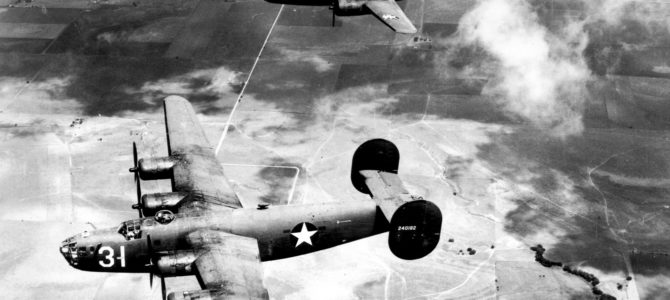To achieve air supremacy in war means to be able to put your assets in the air with the ability to destroy your enemy’s cities, troops, and ability to fight back. In the online course, “The Second World Wars,” Professor Victor David Hanson discusses the technological advances in air power made by German, American, and Japanese forces throughout the course of World World II, and how one side slowly achieved air supremacy.
Before 1941, there was a clear pattern to the victories achieved by German forces. Germany invaded Poland, Denmark, Luxembourg, Holland, Norway, Belgium, France, and Yugoslavia. Each one of these victories was against an unprepared neighbor and a surprise attack. Germany shocked everyone with their sudden domination of European democracies, especially with their success with a new military tactic: blitzkrieg. The blitzkrieg method involved violently and quickly mobilizing forces in the air and on the ground, defeating opponents with series of short attacks.
What we know now is that Germany’s opponents, presumably stunned and alarmed by the attacks, never stopped to evaluate the limitations of Germany’s power, specifically in the air. Could they defeat an enemy in a battle that was not a surprise attack? Could their planes reach the United States? Britain? The answer was no.
The main difference between the Allied powers’ and the Axis powers’ approach to building out their fleet was that the Allies were focused on efficiency, cost, and durability, while the Germans and the Japanese focused on building the biggest and the best weapons. In the long run, the latter proved to create the more accurate and more maneuverable machine in battle, but lacked the support system, the trained pilots, and sheer number of planes in the sky.
Perhaps the biggest strategic mistake Germany made was that they never built a bomber with four engines. Their two-engine bombers — Junkers, Dorniers, and Heinkel models — were first-rate planes, but could not carry more than 5,000 pounds of explosives. A four-engine bomber could carry twice the amount of explosives and travel twice as far as a two-engine.
Meanwhile, the Allied powers were making quantum leaps in technology. Forty percent of the U.S. budget was invested in bombers, fighters, and transport planes. U.S. Army Air Forces developed the B-29 bomber, P-51 fighter, and the jet engine. Of course, their largest impact was participating in the Manhattan Project and the catastrophic atomic bombing on Japan.
As Hanson points out in his book, the Allied bombers took out a significant amount of Germany’s and Japanese’s resources:
German industry was bombed systematically by late 1942, and Japanese factories by late 1944 and 1945. For all the problems with the Allied bombing campaign, no one denied that, in its last months, heavy Allied bombers finally took a terrible toll on Axis aircraft production, transportation, and fuel supplies. The availability of fuel proved the greatest divide between Axis and Allied air power.
Eventually, the Allies bombed the Axis into submission, precluding a land invasion in Japan. Relying on sea power and air power allowed the United States and Britain to avoid the need to land in Europe, unlike the reliance on ground forces in World War I.
Air power did not eliminate fighting on the ground altogether, but it redefined the elements of speed, distance, and geography in military theater. Germany was a much more powerful enemy in WWII than in WWI, yet the Allied forces lost fewer men in the second war (only 2 to 3 percent of their entire military forces, to be exact). It took several years of fighting before Allied forces obtained complete air supremacy, but once they did, it was only a short time before Axis powers were in absolute ruin.









